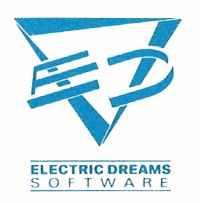Electric Dreams Software
Electric Dreams Software was a video game publisher established in 1985 by former managing director of Quicksilva Rod Cousens and former Software Manager of Quicksilva Paul Cooper.[1] The company published video games for the ZX Spectrum,[2], Commodore 64, Amstrad CPC[3] and the Atari 8-bit family of computers [4] between 1985 and 1989, becoming one of the top eight UK software houses of that decade.[5]
 | |
| Industry | Video games |
|---|---|
| Fate | Defunct |
| Founded | 1985 |
| Defunct | 1989 |
| Headquarters | |
Key people | Rod Cousens, Paul Cooper |
| Products | Spindizzy (1986) Aliens: The Computer Game (1986) |
Software Studios
The publisher's in-house video game developer was Software Studios, set up in April 1986 and run by John Dean and Dave Cummings. Software Studios also handled Activision's products marketed in countries outside the United States. The concept behind this team was to pool resources and ideas between all Electric Dreams projects, but they were also directly responsible for two film tie-in licenses, Aliens: The Computer Game (1986) and Big Trouble in Little China.[5]
Other software titles were chosen for release by Paul Cooper, also formerly of Quicksilva.[1] The company's initial releases were Riddler's Den and I, Of the Mask.[6]
Logo
Electric Dreams Software's logo design is nearly identical to the logo for Disney's Captain EO.[7]
List of releases
- Riddler's Den (1985), David Harper
- I, of the Mask (1985), Spaceman Ltd
- Back to the Future (1985), Software Images
- Winter Sports (video game) (1985), Software Images
- Zaxxon (1985); under license from Sega
- Aliens: The Computer Game (1986), Software Studios
- Big Trouble in Little China (1986), Software Studios
- Dandy (1986), The RamJam Corporation
- Explorer (1986), The RamJam Corporation
- Hijack (1986), Paradise Software
- Mermaid Madness (1986), Soft Design
- Prodigy (1986), MD Software
- Spindizzy (1986), Paul Shirley and Phil Churchyard
- Super Hang-On (1986), Software Studios; under license from Sega
- Xarq (1986), The RamJam Corporation
- Aliens: The Computer Game (1987), Mr. Micro
- Firetrack (1987), Aardvark Software
- FireTrap (1987), Source Software; under license from Data East USA
- Nihilist (1987), Shahid Ahmad
- RMS Titanic
- Starblade (1986), Bob Duncan and Gary Stark
- Star Raiders II (1987), Simon Freeman, Gary Stark and Bruce Poelman; under license from Atari
- Super Sprint (1987), as developer, published by Activision; under license from Atari
- Tempest (1987), David Pridmore; under license from Atari
- Championship Sprint (1988), Catalyst Coders; under license from Atari
- Karnov (1988), Mr. Micro; under license from Data East USA
- R-Type (1988), Manfred Trenz and Andreas Escher; under license from Irem
- Incredible Shrinking Sphere (1989), Foursfield
- Wicked (1989)
- Millennium 2.2 (1989), Ian Bird
References
- Goodwin, Simon (September 1985). "Planning our Future". CRASH (20). Retrieved 2007-11-09.
- "Electric Dreams". World of Spectrum. Retrieved 2007-11-09.
- "Electric Dreams". CPC Zone. Retrieved 2007-11-09.
- "Electric Dreams". Atarimania. Retrieved 2020-08-05.
- "Profile - Electric Dreams". Your Computer (8701). January 1987.
Now Cousens is handling the complete U.K. and European network for Activision as well and Electric Dreams has become one of the top eight U.K. software houses.
- "Frontlines". Your Spectrum (20). November 1985. Retrieved 2007-11-09.
- CRASH issue 60 (January 1989, page 59) highlights the comparison; a link to the archived page can be found on World of Spectrum's Electric Dreams listing.